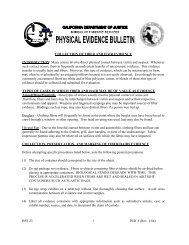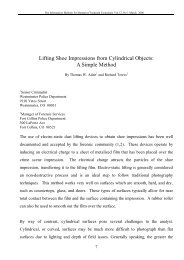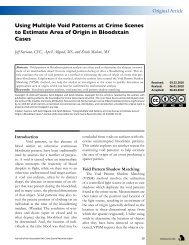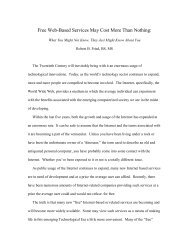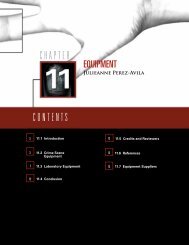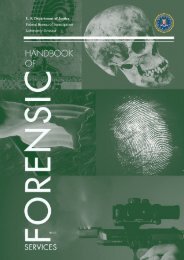PHYSICAL EVIDENCE MANUAL - Crime Scene Investigator Network
PHYSICAL EVIDENCE MANUAL - Crime Scene Investigator Network
PHYSICAL EVIDENCE MANUAL - Crime Scene Investigator Network
Create successful ePaper yourself
Turn your PDF publications into a flip-book with our unique Google optimized e-Paper software.
Physical Evidence Manual<br />
Adopted: May 2002<br />
Revisions: 6<br />
Last Revision: January 31, 2008<br />
16.0 LAMP <strong>EVIDENCE</strong><br />
During a crash investigation it may become important to determine whether or<br />
not a headlight, taillight, or other light unit was on or off at the time of an impact.<br />
These determinations can usually be made if the lamp was cracked or broken,<br />
but in some instances may be made even if the glass was not broken.<br />
During the investigation of crashes where operating conditions of lights are<br />
important, remember:<br />
• Never attempt to turn on the lights to see if they are operational.<br />
• Always check the position of the light switches.<br />
• Question all suspects, victims, and witnesses as to their observations<br />
concerning the operating conditions of the lights involved.<br />
Collection and Packaging of Lamp Evidence<br />
Recovery of all parts of the broken lamp is of primary importance. Carefully<br />
remove the complete lamp unit if possible. Otherwise, remove all parts of the<br />
unit. The parts recovered should include the socket, glass fragments, filament<br />
supports, and filaments. The recovery of the filaments is of greatest value since<br />
more information can be secured from them than any other part of the lamp unit.<br />
Broken lamp units and parts should be marked with the location of the lamp on<br />
vehicle and the orientation of the bulb in the socket. Package the components in<br />
a manner to prevent further damage during shipment (e.g. in a cardboard box or<br />
suspend the bulb in a Styrofoam cup). If the broken unit is one of a pair, attempt<br />
to remove and submit the other unit for comparison whenever practical.<br />
16-1



